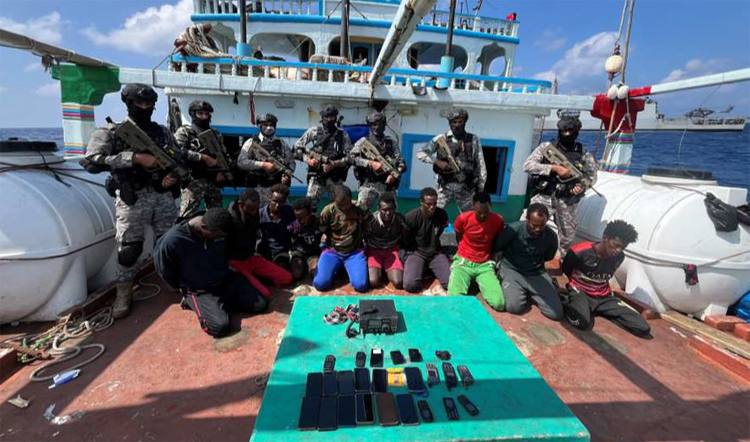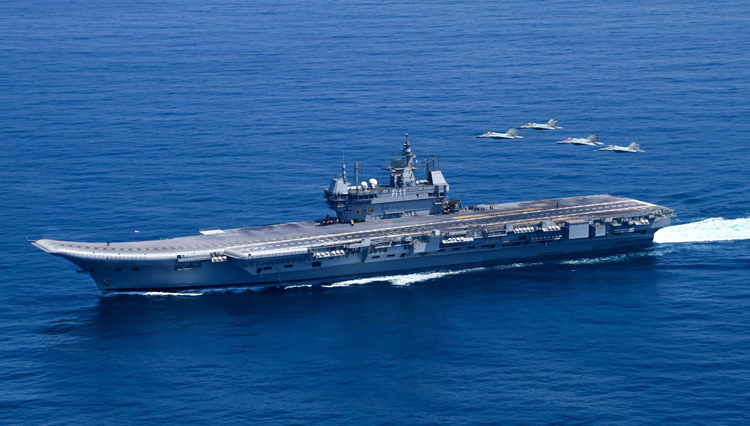INDIAN ARMED FORCES CHIEFS ON OUR RELENTLESS AND FOCUSED PUBLISHING EFFORTS

The insightful articles, inspiring narrations and analytical perspectives presented by the Editorial Team, establish an alluring connect with the reader. My compliments and best wishes to SP Guide Publications.

"Over the past 60 years, the growth of SP Guide Publications has mirrored the rising stature of Indian Navy. Its well-researched and informative magazines on Defence and Aerospace sector have served to shape an educated opinion of our military personnel, policy makers and the public alike. I wish SP's Publication team continued success, fair winds and following seas in all future endeavour!"

Since, its inception in 1964, SP Guide Publications has consistently demonstrated commitment to high-quality journalism in the aerospace and defence sectors, earning a well-deserved reputation as Asia's largest media house in this domain. I wish SP Guide Publications continued success in its pursuit of excellence.
- Prime Minister Modi Visits Punjab’s Adampur Air Base, Interacts with Airmen after Successful ‘Operation Sindoor’; Stern Message to Pakistan
- The layered Air Defence systems that worked superbly, the key element of Operation Sindoor
- Operation Sindoor | Day 2 DGMOs Briefing
- Operation Sindoor: India strikes back with Precision and Purpose
- Operation Sindoor: Resolute yet Restrained
- India’s Operation Sindoor Sends a Clear Message to Terror and the World – ‘ZERO TOLERANCE’
- Japan and India set forth a defence cooperation consultancy framework, talks on tank and jet engines
- Terrorist Attack in Pahalgam in Kashmir: Unfolding a long surgical war against PAK
- Lt General Pratik Sharma takes over Command of Indian Army's Northern Command
Navigating New Naval Frontiers
The upcoming Naval Commanders' Conference is set to discuss burning maritime issues amid growing attacks on ships

A new dimensional, surreptitiously complex like the guerillas of the land, under the proxies of rogue nations, are the new frontiers of wars –not in the limited boundaries of land, but out and open in the vast oceans near and across the Indian Ocean Region. That is the pertinent challenge for the Indian Navy, thinking about the future of war at sea during the first edition of the Naval Commanders' Conference of 2024, taking off on March 5, 2024.
Besides, what is adding to the challenge to India's most formidable and technologically progressive naval forces, is China's rocketing advances on next-generation aircraft carriers loaded with killer missiles and silent submarines matching its ominous military ambitions. So much, that it echoes beyond India and worries the US and its allies as China embarks on smart-assembly production of nuclear-armed submarines. The challenge is actually how to track them lurching closer to the shore, deeply submerged as the new Type 096 ballistic missile submarine poses and many others in the pipeline.
China's rocketing advances on next-generation aircraft carriers loaded with killer missiles and silent submarines matching its ominous military ambitions and adding to the challenges
Alongside, the attacks by the Ansarullah (Houthi) and engagements in the southern Red Sea, the Bab el-Mandeb Strait and the Gulf of Aden, against commercial and military vessels have only added to the growing challenges as India is on course to gain a reputation of a credible naval force which is not only tasked to protect near shore but the entire stretch of IOR and in some cases Indo-Pacific. While the Indian Navy has proven its tag as a First Responder in many recent conflicts, its commitment as a 'Preferred Security Partner in the region also depends on continuously building its advanced naval fleet and presence in that defined oceanic space—and with the constraints of the defence budget.

from Somali Pirates
Held against the backdrop of such geopolitical dynamics, regional challenges, and the current volatile maritime security situation in the region, the first edition of the Naval Commanders' Conference of 2024 which is scheduled to commence on March 5, 2024 will serve as a platform for Naval Commanders to deliberate on strategic, operational, and administrative matters concerning maritime security in such scenarios unfolding fast.
The inaugural session of the Conference will have the Defence Minister embarking at sea to witness both aircraft carriers demonstrating the Indian Navy's ability to conduct twin carrier operations
Befitting the Conference, this time around, in its first phase, it will be held at sea. The inaugural session of the Conference will have the defence minister embarking at sea to witness both aircraft carriers demonstrating the Indian Navy's ability to conduct twin carrier operations. During the three-day event, Defence Minister Rajnath Singh will also address the Naval Commanders alongside the Chief of Defence Staff, the Chiefs of the Indian Army, and the Indian Air Force.
According to the senior naval officers, the military leaders will also deliberate the convergence of the three Services in light of the common national security environment. "They will explore avenues to enhance tri-service synergy and readiness in defence of the nation and India's national interests," said a senior naval commander.
The Chief of the Naval Staff, Admiral R. Hari in his address at "Aerospace and Defence: Capability Roadmap 2030," at the USI outlined the current and future paradigms and said: "proliferation of sensitive tech and the asymmetric advantages it gives is an area of focus and concern."
The outcome is due to a new strategic alignment of the nations which has resulted in a spillover of the kinetic actions on land into the Maritime Domain
Especially, in the last six months, there have been significant changes in the geo-political landscape in the IOR due to the ongoing Israel-Hamas conflict. The outcome is due to a new strategic alignment of the nations which has resulted in a spillover of the kinetic actions on land into the Maritime Domain. Along with the drone and missile attacks on mercantile shipping, a resurgence of piracy has also been witnessed.
The new naval strategy
Amid the growing challenges, what is further adding is the fact that many navies have ignored land-attack and air defence capabilities. Besides the current Houthis-led attack, the impending question largely rests on the challenges posed by China's large and diverse arsenal of missiles, testing the navies' air defences at multiple fronts.
The omnipresent unmanned aerial vehicles (UAVs)—cheap, lethal, and easily available—are already showing signs of deeper problems against the existing range of much costlier missiles and air defence systems. The attacks at the Red Sea have indeed laid the ground for such strategic manoeuvring in terms of capability roadmap for the Indian navy.

While the Indian navy is still adding to its platform-centric strategy and addressing the required number of warships in its fleet, the unnamed-centric autonomous systems, much smaller in size and cost, will be the point of debate and discussion due to the Commanders' conference.
The trend is well analysed as the Navy Chief, during the interaction with the author, highlighted the advanced tech-based Sensors and Weapons (kinetic and non-kinetic options), Platforms (carriers and nuclear subs, etc), EW (having on board platforms), Cyber (leveraging AI for real-time threat detection and response), Tech Revolution (RMA and AI-based solutions) and Unmanned systems (drones, swarm).
The Indian Navy plans to order another Indigenous Aircraft Carrier (IAC) similar to the INS Vikrant and at least three nuclear-powered submarines and six diesel-electric conventional submarines
In fact, in the navy's quest for moving ahead on curves on such technologies, Vice Admiral Sanjay Vatsayan, DCIDS (PP&FD) hinted at the greater focus on the Cyber domain and its components (quantum computing, AI) and robotics and its components (exoskeletons, killer robots). However, it will require research and collaboration between various elements for indigenous R&D, and safe development and deployment, he added.

In the last few years, the Navy has seen the induction of the T-DAC cell, NIIO, NTAC, and the SPRINT initiative as avenues of indigenous development.
Additionally, 132 ships were constructed indigenously, and 64 ships and submarines are under construction. Only two ships being constructed abroad, will be the last two to ever be constructed abroad for the Indian Navy.
Capability Roadmap for Indian Navy (IN)
As evident, the Indian Navy plans to order another Indigenous Aircraft Carrier (IAC) similar to the INS Vikrant and at least three nuclear-powered submarines and six diesel-electric conventional submarines. While the IN has set the ambitious target to achieve 175 warships by 2035, the near-adversary, China's scale is humongous, projecting ~555 warships by 2030.
At the same time, the idea of carrier battlegroups is gaining ground as it adds to overall capability in terms of multi-mission escort and support vessels with integrated anti-air, anti-surface, and anti-submarine warfare capabilities; the UAVs and UWUs are further added to the carrier striker. The Commanders' Conference will have to resolve the dichotomy of offence and defence and seek larger budgetary allocations to achieve its objective.
The Commanders' Conference will have to resolve the dichotomy of offence and defence and seek larger budgetary allocations to achieve its objective
Another dimension which is accreted widely but implemented slowly is the trust in nuclear attack submarines (SSN) for India—built indigenously with the overall goal of acquiring 24 submarines by 2030, consisting of 18 conventional and six nuclear-powered submarines. Here the silver lining is Arihant-class SSBNs which the Indian navy boosts its progressive and futuristic outlook for the nuclear deterrent in all possible situations.
However, all is not well on the front as far as the next-generation submarine Project P-75I is concerned. A lot of time has already passed while deliberating on Air-Independent Propulsion (AIP) systems for the P-75I and choosing a foreign partner under the Strategic Partnership (SP). A good decision is awaited on the aircraft carrier (IAC II) that will carry forward the massive expertise that India Navy & Industries have gained which is equally about a good 50,000 tonnes of shipbuilding for the economy as well. The Commanders' Conference is slated to discuss all that are at stake.
Manish Kumar Jha is a Consulting & Contributing Editor for SP's Aviation, SP's Land Forces and SP's Naval Forces and a security expert. He writes on national security, military technology, strategic affairs & policies.





